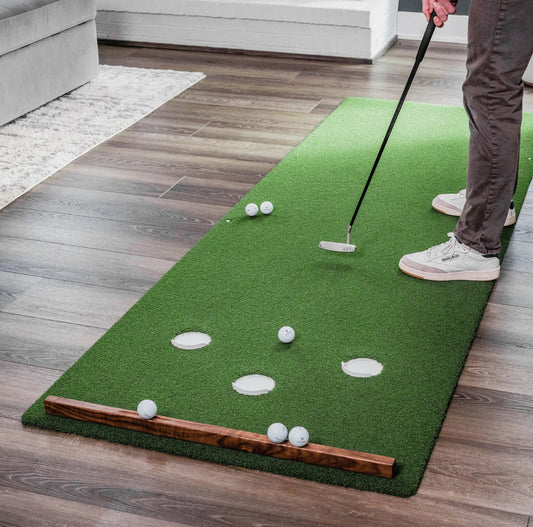Every golfer wants to lower their scores, but the road to improvement begins with frequent practice. You can roll your putts on an indoor putting green or outdoor green, but which is the right practice tool for your situation?
In this comprehensive guide, we'll dissect the key differences between indoor putting mats and outdoor putting greens, evaluate their advantages, and help you determine which option will lead you to become a better putter. With a focus on practicality, efficacy, and individual golfing needs, we'll help you decide the best option for your game.
What Is an Indoor Putting Mat?
An indoor putting mat is a convenient practice tool designed to fit within your home or office. The size and features of these mats vary and can be tailored to your preferences, from their dimensions to the number of holes included.
The best indoor putting greens, like PrimePutt, use tour-grade turf to mimic the texture and feel of a well-kept green, allowing you to refine speed and distance control from virtually anywhere indoors. And because indoor putting mats are easy to roll up and store, they work well in small areas or on the go.
What Is an Outdoor Putting Green?
An outdoor putting green can refer to a few different things. Some outdoor putting greens are custom-made for backyards and require extensive landscaping and outdoor remodeling expertise. These setups are permanent and may require regular maintenance, and some areas may not be suitable depending on the weather.
Outdoor putting greens also come in DIY kits, which have varying sizes and features depending on your preference. For example, some are permanent, resistant to weather, and have built-in drainage, while others are portable and not meant to withstand the elements.
Indoor Putting Mat vs. Outdoor Putting Green: Key Differences
While both indoor putting mats and outdoor putting greens will help you practice your short game and sink more golf balls, it's essential to consider a few key differences.
Materials
Indoor putting mats are typically made of artificial turf that aims to mimic the feel of a golf course green. The putting surface offers consistent conditions for practice.
On the other hand, outdoor putting greens can be either faux turf or natural grass, with the latter providing a more authentic experience. Natural greens can adapt to changing weather and terrain conditions but require more upkeep and maintenance.
Purpose and Design
An indoor mat may be constrained by room size, while outdoor greens can be customized to replicate specific course features.
Indoor mats are designed for convenience, providing a controlled environment to work on speed control and distance from the comfort of your home or office. However, there are many design options and customization available—depending on the brand you choose—offering everything from alignment aids or alignment lines to golf ball return and moveable cups.
Outdoor greens, however, offer variety and unpredictability, replicating real-course conditions, different shots, and strategies.
Portability
When it comes to portability, indoor putting mats have a clear advantage. They make it easy to practice putting indoors anywhere you choose and can be rolled up and stored away or transported.
Outdoor greens lack this flexibility or may be hard to move around due to the size and fixed components.
Cost
The cost varies widely between the two. Indoor mats can be relatively inexpensive, depending on the quality and brand.
Outdoor greens, especially real-grass ones, require significant initial installation and ongoing maintenance costs.
Indoor Putting Mat vs. Outdoor Putting Green Benefits
Both practice tools will help you build repetition and improve your stroke, but they vary in terms of benefits. Here's how they compare:
Indoor Putting Mat Benefits
The main benefit of an indoor putting mat is that your practice is not dependent on the weather. You can use it in virtually any indoor space without distractions from other golfers practicing. You also practice at your own pace, which helps you stay focused on your mechanics.
With a putting mat at home or in your office, rushing to the golf course to soak up the last 45 minutes of sunlight can be a thing of the past. You can putt on your own schedule whenever and wherever you want. While they don't replace the real thing, you can refine your technique and prepare for the next time you hit the course.
Outdoor Putting Green Benefits
A faux-turf or grass outdoor putting green's main advantage is that it offers a close experience to putting on a real green. The size, shape, speed of the green, undulations, number of cups, and additional features can all be tailored to your specifications, offering an immersive putting experience—though it comes at a premium cost.
No golf course has flawlessly flat greens, which means mastering the art of putting on an incline is essential. Practicing on a surface with breaks and undulations equips you with the skills to excel as a putter, preparing you for the reality of the golf course. However, simple DIY outdoor putting green kits may not offer these advantages.
So, Which Is Better?
Deciding between indoor putting greens and outdoor putting greens depends on your individual circumstances. However, if you value convenience, versatility, and all-season practice, an indoor putting mat holds an edge.
With putting greens like PrimePutt, you can mimic the feel of a natural green, regardless of space, weather, or location constraints. It doesn’t require plots of outdoor land or serious installation work, allowing you to get authentic practice breaking putts right out of the box. And with PrimePutt, you can count on excellent customer service and a satisfaction guarantee in case you’re unsatisfied with your putting mat.
Frequently Asked Questions
Here are some of the most commonly asked questions we hear on this subject.
What’s best for practicing: an indoor putting mat or outdoor putting green?
Both are excellent options for getting in some practice time. However, being able to putt on a real putting green or on tour-quality turf is going to offer you the most variety when it comes to practice. You can work on stroke maintenance, distance control, green reading, and much more.
Putting on an indoor putting mat doesn’t offer you as many ways to work on every aspect of your putting as being on an outdoor putting green does, but an indoor green is significantly more affordable and convenient.
Do I need a country club membership to practice my putting?
No. There are plenty of public golf courses with great practice facilities where you can work on your putting game. The great thing about public or city golf courses is that anyone can use them, whether it's to play a round of golf or get in a solid practice session.
What type of putter should I use?
This depends on a multitude of factors, some of which are the type of putting stroke you have, what putters you like the look of, and what height putter you need. There are some more forgiving putters for high handicappers, but even high handicappers can benefit from using a custom-fit putter.
Making sure you are using the right one for your specific style of putting stroke is the single most important factor. So if you are new to the game, it’s essential to know the difference between the two styles of putter heads: mallet and blade putters.
When looking for a putter, the place to start is basically finding out which type of putting stroke you have and then pairing it with the right style of putter head. Rest assured that there is such a thing as using the wrong putter, especially as it relates to the type of putting stroke you have.





